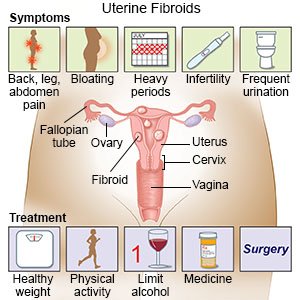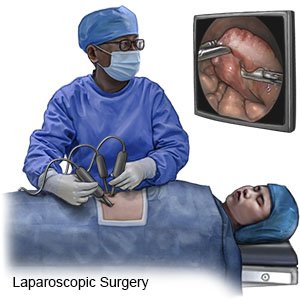Myomectomy
Medically reviewed by Drugs.com. Last updated on May 6, 2024.
AMBULATORY CARE:
What you need to know about a myomectomy:
A myomectomy is surgery to remove one or more myomas from your uterus. Myomas are also called fibroids or leiomyomas. A myomectomy can be done in several ways. Your surgeon will talk to you about the best way for you. This may depend on your age, health, how many fibroids you have, and where they are located.
 |
How to prepare for a myomectomy:
- Your surgeon will talk to you about how to prepare for surgery. You may need to stop taking blood thinners or aspirin several days before your procedure. This will help decrease your risk for bleeding. Arrange for someone to drive you home after your procedure.
- Your provider will tell you what medicines to take or not take on the day of your procedure. You may be given an antibiotic to prevent infection. Tell healthcare providers if you have ever had an allergic reaction to an antibiotic. You may be told not to eat or drink anything after midnight on the day of your procedure.
What will happen during a myomectomy:
- Depending on the kind of surgery you have, you may need general or local anesthesia. General anesthesia will keep you asleep and free from pain during surgery. With local anesthesia, you may feel some pressure or pushing, but you should not feel any pain.
- A tissue removal system may be used for a small fibroid. This procedure may be right for you if you want to keep having regular monthly periods and plan to become pregnant in the future. Your provider will guide a wand through your vagina and into your uterus. One side of the wand is made to cut the fibroid into pieces. Suction is used to pull the small pieces into the wand to remove them from your uterus. When all the pieces have been removed, the wand will be removed.
- For a laparoscopic myomectomy, your surgeon will make smaller incisions in your abdomen. He or she will put tools through these incisions to open your uterus and locate the fibroid. Your surgeon will then cut the fibroid into smaller pieces. The fibroid will be removed through one of the smaller incisions or through a larger incision made on your abdomen. Your surgeon will close the incisions with medical tape. Bandages will cover your wounds to keep them clean.

- You may need an open myomectomy for a larger fibroid, or for several fibroids. For an open myomectomy, your surgeon will make an incision across your abdomen. He or she will open your uterus and find the fibroid. The fibroid will be removed from your uterus. Your surgeon will close the incisions with stitches. Bandages will cover your stitches to keep them clean.
What to expect after a myomectomy:
You may be able to go home the same day, or you may need to stay in the hospital. Depending on the type of procedure of surgery you had, you may have mild cramping or pain. You may have 1 large scar or a few small scars if you had a laparoscopic or open procedure. Scars should fade over time. You may also have some spotting. This usually lasts a few days, but it is normal for spotting to last up to 6 weeks.
Risks of a myomectomy:
You may get an infection in your wound. Your bowel, blood vessels, or uterus may be damaged. You may bleed more than expected and need a blood transfusion or a hysterectomy (surgery to remove your uterus). If you have a hysterectomy, you cannot get pregnant. After surgery, you may have trouble urinating or having a bowel movement. You may get fibroids again, even if your surgery is successful. You may have scar tissue that causes pain or makes it harder for you to get pregnant. You may get a blood clot in your leg or arm. This may become life-threatening.
Call your local emergency department (911 in the US) for any of the following:
- You feel lightheaded, short of breath, and have chest pain.
- You cough up blood.
Seek care immediately if:
- Your arm or leg feels warm, tender, and painful. It may look swollen and red.
- You cannot urinate, or you urinate very little.
- You have bleeding from your vagina that does not stop.
- You suddenly have severe abdominal pain.
- Your stitches come apart.
Call your surgeon or gynecologist if:
- You start to bleed more than usual during or between your monthly periods, after your fibroids are removed.
- You are constipated.
- You feel new pressure in your abdomen.
- You have a fever.
- You have nausea or are vomiting.
- You have new pain in your abdomen, or you have pain that is getting worse.
- Your wound is swollen, red, or has pus coming from it.
- You have questions or concerns about your condition or care.
Medicines:
You may need any of the following:
- Prescription pain medicine may be given. Ask your healthcare provider how to take this medicine safely. Some prescription pain medicines contain acetaminophen. Do not take other medicines that contain acetaminophen without talking to your healthcare provider. Too much acetaminophen may cause liver damage. Prescription pain medicine may cause constipation. Ask your healthcare provider how to prevent or treat constipation.
- Antibiotics help prevent or fight a bacterial infection.
- Take your medicine as directed. Contact your healthcare provider if you think your medicine is not helping or if you have side effects. Tell your provider if you are allergic to any medicine. Keep a list of the medicines, vitamins, and herbs you take. Include the amounts, and when and why you take them. Bring the list or the pill bottles to follow-up visits. Carry your medicine list with you in case of an emergency.
Wound care:
Care for your wound as directed. You may need to wash the wound with soap and water. Dry the area and put on new, clean bandages as directed. Change your bandages when they get wet or dirty.
Self-care:
Your healthcare provider will give you specific instructions based on the kind of myomectomy you had. The instructions will include when it is safe to have sex and return to other daily activities. It is important to follow all of your instructions. The following are general guidelines to help your body heal and to help prevent infection:
- Rest as needed. Rest and sleep will help your body heal.
- Follow your healthcare provider's instructions for activity. If you had the least invasive kind of procedure, you may be able to start your normal activities within 2 days. For a laparoscopic or open surgery, you may need to be careful for 4 to 6 weeks while you recover. This includes no strenuous exercise, such as lifting weights. Your provider will tell you when it is okay to start driving and to return to work.
- Do not use tampons, douche, swim, take a bath, or soak in a hot tub for 6 weeks. This will help prevent an infection.
- Ask about birth control. It may take a few months for your monthly period to return to normal. Ask your healthcare provider about your risk for pregnancy. You may need to use birth control to prevent pregnancy for a few months while your body heals. Your healthcare provider will tell you when it safe for you to try to become pregnant if you want to try.
Follow up with your surgeon or gynecologist as directed:
You may need to return for an ultrasound to check for new fibroids. Write down your questions so you remember to ask them during your visits.
© Copyright Merative 2024 Information is for End User's use only and may not be sold, redistributed or otherwise used for commercial purposes.
The above information is an educational aid only. It is not intended as medical advice for individual conditions or treatments. Talk to your doctor, nurse or pharmacist before following any medical regimen to see if it is safe and effective for you.
Further information
Always consult your healthcare provider to ensure the information displayed on this page applies to your personal circumstances.
